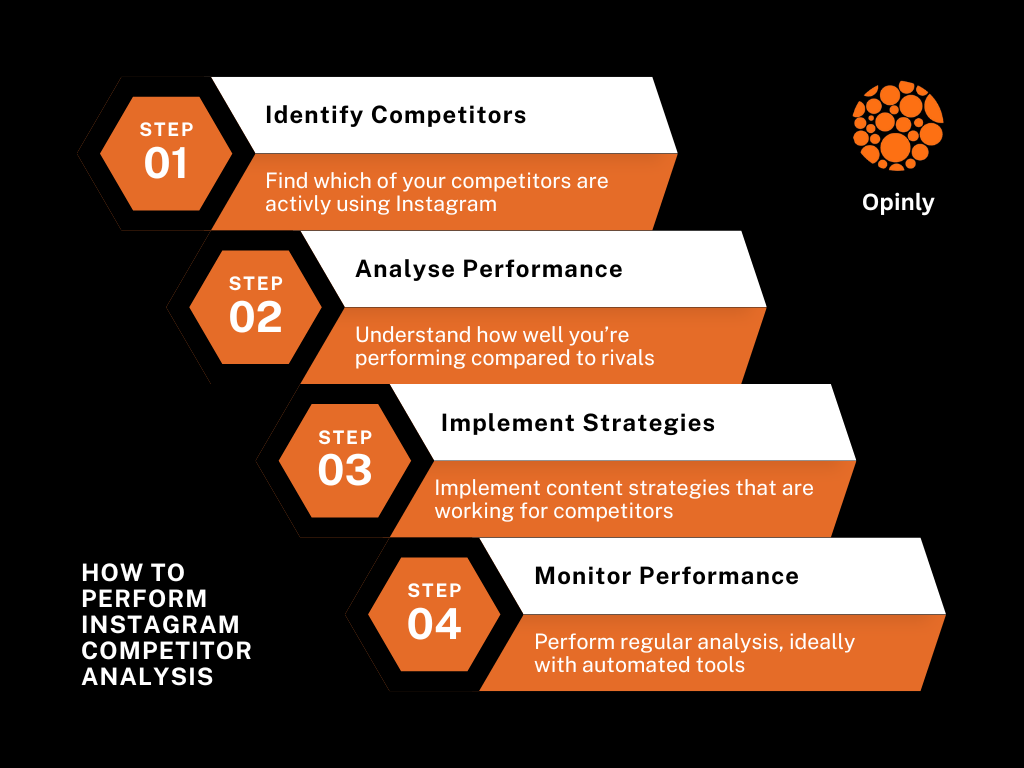What are the 4 P's of Competitor Analysis?
Learn the 4 P's of competitor analysis: Product, Price, Promotion, and Place. Use these strategies to outsmart your competition.

Competitor analysis is all about gathering and understanding information about your competitors, what products they sell, how much they charge, how they promote their business, and where they sell their products.
By keeping an eye on their strengths and weaknesses, you can find new ways to improve your own offerings, attract more customers, and ultimately stay ahead in the market.
One of the most effective ways to break down a competitor's strategy is by using the 4 P's of Competitor Analysis: Product, Price, Promotion, and Place.
This simple framework helps you analyze key areas of a competitor’s business and can give you insights into what makes them successful—or where they're falling short.
In this guide, we’ll dive into each of these 4 P’s and show you how to use them to your advantage.
Whether you're a small business or a large company, understanding these factors will help you outsmart your competition and grow your business!
Why Competitor Analysis is Important for Your Business Growth

In business, it’s not just about what you do—it’s also about what your competitors are doing. Knowing their moves can give you the edge you need to grow your own business. This process is called competitor analysis, and it plays an important role in shaping your business strategy.
Let’s break it down:
- Understanding the Market: Competitor analysis helps you see the bigger picture of your industry. By studying your competitors, you learn what products or services are popular, which marketing strategies are working, and what customers are looking for. This gives you a clear idea of where your business stands and where you can improve.
- Shaping Product Development: Imagine you’re developing a new product. By analyzing what your competitors offer, you can identify gaps in the market or areas where your product can stand out. Maybe they’re missing a key feature, or their product lacks quality. This insight allows you to create something better, making your product more attractive to customers.
- Improving Your Marketing Strategy: Competitor analysis also helps you fine-tune your marketing efforts. You can learn from their successes and mistakes—what kind of promotions work best, which platforms (like social media or Google Ads) they use effectively, and how they engage with their audience. By doing this, you can adjust your own marketing strategy to attract more customers and build a stronger brand presence.
- Boosting Customer Satisfaction: By knowing what competitors offer, you can anticipate customer needs better. If your competitor has long shipping times or poor customer service, that’s an opportunity for you to do better. This can help you win over their customers by providing a more satisfying experience.
By continuously monitoring what others are doing, you can make smarter decisions that help your business grow faster, stay ahead of trends, and keep your customers happy.
Overview of the 4 P’s of Competitor Analysis

What are the 4 P's of Competitor Analysis, and why do they matter?
The 4 P's of Competitor Analysis — Product, Price, Promotion, and Place—are key factors you should look at when studying your competition.
Each "P" helps you break down different parts of your competitors' business strategy, giving you a clear view of what they're doing well and where you can do better. Let’s look at each of them in simple terms.
1. Product
The first "P" stands for Product. This is all about what your competitor is offering—whether it’s a physical product or a service.
- Questions to ask: What features does their product have? How is the quality? Are customers satisfied with it?
- Why it matters: By studying their product, you can see how yours compares. Maybe their product has a feature yours doesn’t, or maybe your product is better but you’re not highlighting it enough. Knowing these details can help you improve what you offer.
2. Price
The second "P" is Price, which is exactly what it sounds like—how much your competitors are charging for their product or service.
- Questions to ask: Are they charging more or less than you? Do they offer discounts or special deals? What pricing strategy are they using?
- Why it matters: Pricing is a huge factor for customers when deciding where to spend their money. If your competitors are offering similar products at a lower price, you might need to adjust. Or, if you charge more, you’ll need to make sure your product offers something that justifies the higher price.
3. Promotion
The third "P" is Promotion. This refers to how your competitors are marketing and advertising their product.
- Questions to ask: What types of promotions are they running? Are they using social media, email marketing, or Google Ads? How are they engaging with their audience?
- Why it matters: Promotion is how businesses get their products in front of potential customers. If your competitors are using certain advertising strategies that seem to work, you might want to try similar approaches. On the other hand, if you notice gaps in their marketing, it could be an opportunity for you to outshine them.
4. Place
The last "P" is Place, which refers to where your competitors sell their products and how they distribute them to customers.
- Questions to ask: Do they sell online, in stores, or both? Are they using third-party platforms like Amazon or Etsy? How efficient is their delivery process?
- Why it matters: Place is all about convenience. If your competitors make it easier for customers to find and buy their products, you may need to improve your own distribution methods. For example, if they offer free delivery while you don’t, that could be something worth considering.
How the 4 P’s Help You Understand Competitor Strategies

By looking at these four areas—Product, Price, Promotion, and Place—you get a complete picture of how your competitors run their business. This information helps you identify their strengths and weaknesses, which in turn helps you improve your own strategies.
- If their product is lacking something, you can make sure yours fills that gap.
- If their price is too high or too low, you can adjust yours accordingly.
- If their promotion is working well, you can learn from their tactics.
- If their place or distribution isn’t as efficient, you can find ways to do better.
How to Implement the 4 P’s into Your Competitor Analysis Strategy

How can you use the 4 P’s to stay ahead of your competition?
Now that you know what the 4 P’s of Competitor Analysis are—Product, Price, Promotion, and Place—it’s time to learn how to actually use them to your advantage.
By following a simple step-by-step process, you can gather valuable insights about your competitors and apply them to improve your own business strategy.
Step-by-Step Guide to Using the 4 P’s Framework
Step 1: Identify Your Competitors
Start by figuring out who your direct competitors are. These are businesses that sell similar products or services to the same type of customers as you.
- Tip: Use tools like Google Search, social media, or competitor research platforms (e.g., SEMrush or Ahrefs) to identify your top competitors. You can also check customer reviews to see which companies your audience is comparing you to.
Step 2: Analyze Their Product
Once you’ve identified your competitors, take a close look at what they offer. This includes the features, quality, and variety of their products or services.
- Tip: Visit their website, read customer reviews, or even try out their products yourself. This will give you firsthand experience of what they’re offering and how it compares to your product.
Step 3: Check Their Pricing Strategy
Next, analyze how your competitors price their products. Are they targeting budget shoppers, or do they offer premium, high-priced options?
- Tip: Look at their pricing on their website, online marketplaces, or other platforms. Keep an eye out for any discounts or promotions they offer to get a better sense of their pricing strategy.
Step 4: Study Their Promotion
Examine how your competitors are promoting their business. Are they running ads on social media? Do they send out email newsletters? How do they engage with customers online?
- Tip: Follow their social media accounts, subscribe to their newsletters, and monitor their advertising. You can also use tools like SpyFu or SimilarWeb to see which platforms they’re using for paid ads and how much traffic they get from these efforts.
Step 5: Evaluate Their Place (Distribution)
Finally, look at where and how your competitors are selling their products. Are they online-only, or do they have physical stores? Do they offer fast shipping or multiple delivery options?
- Tip: Check their website for shipping and distribution details, or visit their physical locations if they have any. You can also read customer reviews to see what people are saying about their buying experience and delivery process.
Practical Tips on How to Gather Data and Insights Efficiently
Here are some easy ways to gather information for each of the 4 P’s without spending too much time or money:
- Use Competitor Analysis Tools: Tools like SEMrush, Ahrefs, and SpyFu can give you a ton of information about your competitors’ online presence, including their products, pricing, and promotions.
- Social Media Monitoring: Follow your competitors on social media platforms like Instagram, Facebook, and Twitter. Watch how they interact with customers and promote their products.
- Customer Reviews: Read reviews on platforms like Google, Amazon, or Yelp. Customers often mention specific things they like or dislike about a competitor’s product, service, or delivery process.
- Sign Up for Competitors' Newsletters: This will give you direct insight into their promotions, discounts, and marketing strategies.
- Google Alerts: Set up Google Alerts for your competitors' names, products, or services to get real-time updates on what they’re up to.
How to Apply Your Findings to Improve Your Business Strategy

Once you’ve gathered all your insights from the 4 P’s, it’s time to use them to improve your own business strategy. Here’s how:
- Improve Your Product: If you notice a competitor’s product has a feature yours doesn’t, think about how you can add or enhance your own product to match or exceed that. If customers are complaining about their product’s quality, you can use that as a selling point for your superior product.
- Adjust Your Pricing: If your competitor is charging less for the same product, you might want to consider lowering your price or offering more value to justify a higher price. Offering limited-time discounts or promotions can also attract price-conscious customers.
- Enhance Your Promotion: If you see your competitor getting great results from a specific marketing channel (like Instagram ads), you can test that out for your own business. You can also learn from what isn’t working for them and avoid making the same mistakes.
- Streamline Your Distribution (Place): If customers are frustrated with your competitor’s slow delivery times, focus on improving your shipping options to give customers a better experience. If your competitor is only online, you might consider opening a physical pop-up store to reach more customers in person.
Common Mistakes to Avoid When Conducting Competitor Analysis

When conducting competitor analysis, there are a few common pitfalls that can limit the effectiveness of your strategy. By being aware of these mistakes, you can ensure that your analysis gives you the best insights to help your business grow.
1. Over-focusing on One of the 4 P’s
It’s easy to get caught up in just one of the 4 P’s—like price or product—and overlook the others. For example, you might spend a lot of time adjusting your prices to compete but forget to improve your marketing or distribution.
- Why this is a mistake: Focusing too much on one aspect can leave you vulnerable in other areas. Your competitors might have a better promotion strategy or be reaching more customers through efficient distribution, even if their prices are higher or products are similar.
- How to avoid it: Make sure to look at all 4 P’s—Product, Price, Promotion, and Place—so you get a well-rounded understanding of your competitors' strategies. Each of these factors is important for the overall success of your business.
2. Ignoring Smaller, Emerging Competitors
Many businesses tend to focus only on their biggest competitors and overlook smaller or emerging businesses. These newer competitors might not be as big now, but they could quickly grow and take market share if you're not paying attention.
- Why this is a mistake: Smaller competitors often bring fresh ideas and new ways of doing things. They can be more agile and innovative, which means they could eventually become major players in your industry.
- How to avoid it: Keep an eye on up-and-coming competitors, especially ones that are growing fast or have a unique approach. Monitor social media, industry forums, and customer reviews to spot new players who might pose a future threat.
3. Overlooking Long-term Strategic Advantages in Favor of Short-term Wins
Sometimes, businesses get too focused on quick fixes or short-term gains, like lowering prices to attract customers or running aggressive promotions. While these moves might give you a short-term boost, they don’t always lead to long-term success.
- Why this is a mistake: Chasing short-term wins, like temporary price cuts, can hurt your business in the long run if it lowers your profits or damages your brand image. Competitor analysis is about understanding sustainable strategies that help you grow over time, not just quick wins.
- How to avoid it: Focus on long-term strategic advantages like building brand loyalty, improving product quality, or enhancing customer experience. These factors will keep your business competitive for years, even if your competitors offer temporary deals or lower prices.
Key Takeaway: A Balanced Approach Wins
When doing competitor analysis, it's important to take a balanced approach. Look at all aspects of your competitors' business, keep an eye on smaller players, and prioritize long-term competitor strategies over quick fixes. This will ensure your business stays competitive and continues to grow in a sustainable way.
Conclusion
Competitor analysis is a powerful tool that can help your business grow and stay ahead of the competition. By using the 4 P's—Product, Price, Promotion, and Place, you can get a clear picture of what your competitors are doing and where you can improve.
Avoid common mistakes like focusing too much on one area, ignoring smaller competitors, or chasing short-term wins. Instead, take a balanced approach to your strategy and focus on long-term success. With the right insights, you’ll be able to make smarter decisions that set your business apart and help you thrive in a competitive market.
Frequently Asked Questions
1. What is competitor analysis in marketing?
Competitor analysis in marketing is the process of researching and understanding what your competitors are doing. This includes looking at the products they sell, their prices, how they advertise, and where they sell their products. By knowing this, you can find ways to improve your own marketing strategy and stay competitive.
2. How do I choose the right tools for competitor analysis?
Choose tools based on your specific needs. If you want to track how your competitors rank on search engines, tools like SEMrush or Ahrefs are great. For social media insights, tools like Hootsuite can help. Pick a tool that fits your budget and covers the areas you want to analyze, like product pricing, SEO, or advertising.
3. Can small businesses benefit from competitor analysis?
Absolutely! Competitor analysis helps small businesses identify opportunities to stand out. By learning what your competitors are doing right (or wrong), you can adjust your own strategies, attract more customers, and find ways to grow—even if you're a small business.




